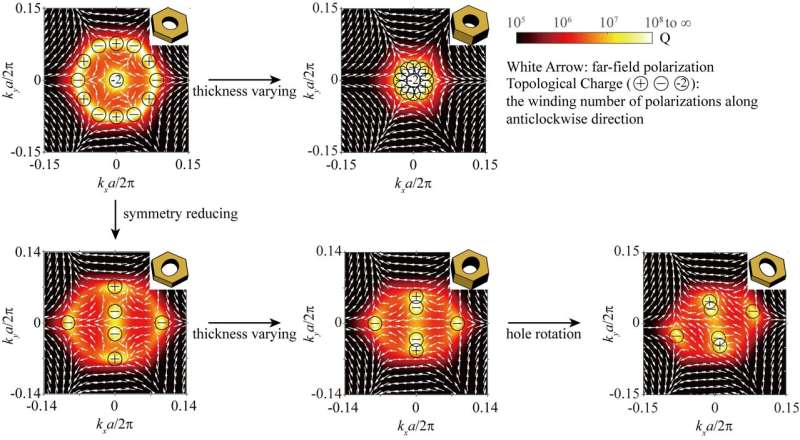Improving the robustness of bound states in the continuum with higher topological charges

Bound states in the continuum (BICs) have attracted broad research interest owing to their excellent performance in light confinement, which can boost light-matter interaction. BICs can eliminate the radiation loss to theoretically achieve an infinity quality factor Q. However, in practical on-chip resonators, there are inevitable fabrication imperfections that couple BICs to nearby radiative states by scattering, thus limiting the available Q.
To suppress the scattering loss, the improvement of light confinement in the nearby radiative states is required. Multiple BICs can be tuned to the same position to form a merging BIC using the topological properties of BIC. This physical mechanism can significantly enhance the Q of nearby states over a broad wavevector range and improve the robustness of BICs against the scattering loss of fabrication imperfections.
For photonic crystal slabs, the polarizations of the far-field radiation form a polarization vortex around a BIC in momentum space. The BIC is located at the topological singularity, whose polarization direction cannot be defined, so there is no radiation loss. The winding number of polarizations along the counterclockwise direction defines the topological charge of BICs. BICs are topologically protected following the topological charge conservation. They are tunable in momentum space with the variation of structural parameters.
However, to date, the construction of merging BICs involves only the manipulation of fundamental topological charges. On the one hand, the higher-order topological charges can be regarded as consisting of multiple fundamental topological charges, and hence a higher-order charged BIC itself can improve the robustness of a BIC against the scattering loss. On the other hand, by reducing the structural symmetry, BICs with higher-order topological charges can split into multiple BICs with fundamental topological charges, which can construct merging BICs with other physical mechanisms induced BICs.
In a new paper published in Light: Science & Applications, Prof. Meng Xiao from Wuhan University, Prof. Hongxing Xu's team from Wuhan University, and Prof. Che Ting Chan from the Hong Kong University of Science and Technology cooperated to propose a novel physical mechanism for realizing merging BICs through manipulating higher-order topological charges.
In the photonic crystal slab with a triangular lattice, there is a symmetry-protected BIC with a topological charge of -2 at the Γ point. When the thickness of the slab is appropriate, accidental BICs with topological charges of ±1 appear at off-Γ points, which are formed by the accidental cancelation of radiation loss because of destructive interference. By varying the thickness, multiple accidental BICs can be simultaneously tuned to the G point, forming a merging BIC with a higher-order charged BIC. The Q factors of the nearby radiative states have been significantly enhanced for nearby radiative states compared with isolated BICs or merging BICs with only fundamental charges. In short summary, merging BICs involving higher-order charges can further improve the light confinement and suppress the scattering loss caused by fabrication imperfections.
By replacing cylindrical holes with elliptical cylindrical holes, the symmetry of the structure is reduced and higher-order charged BICs are no longer allowed at the Γ point. Because of topological charge conservation, BICs with the higher-order topological charge split into off-Γ BICs. The split BICs can be tuned in momentum space by varying the structural parameters. They can be simultaneously tuned to the Γ point to form a merging BIC, or to the same position with accidental BICs and form a merging BIC at off-Γ points.
By rotating elliptical cylindrical holes, the mirror symmetry is further broken and BICs are turned away from the mirror plane. By choosing a suitable rotation angle and slab thickness, the merging BIC are steerable with a designed momentum, which is of great significance for improving the performance of direction-related applications.
More information: Meng Kang et al, Merging bound states in the continuum by harnessing higher-order topological charges, Light: Science & Applications (2022). DOI: 10.1038/s41377-022-00923-4
Journal information: Light: Science & Applications
Provided by Chinese Academy of Sciences





















